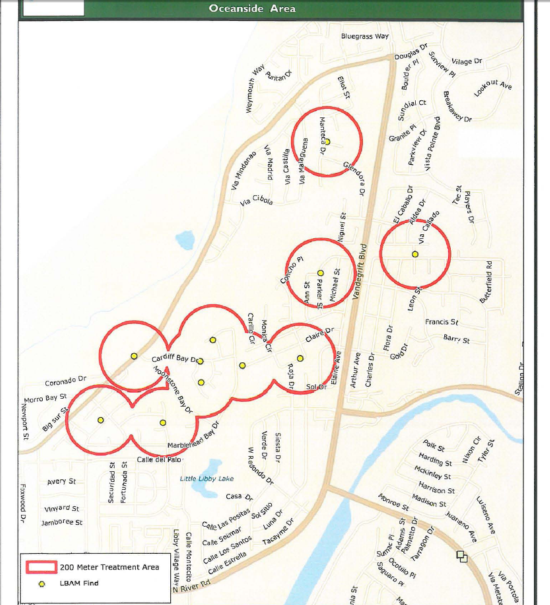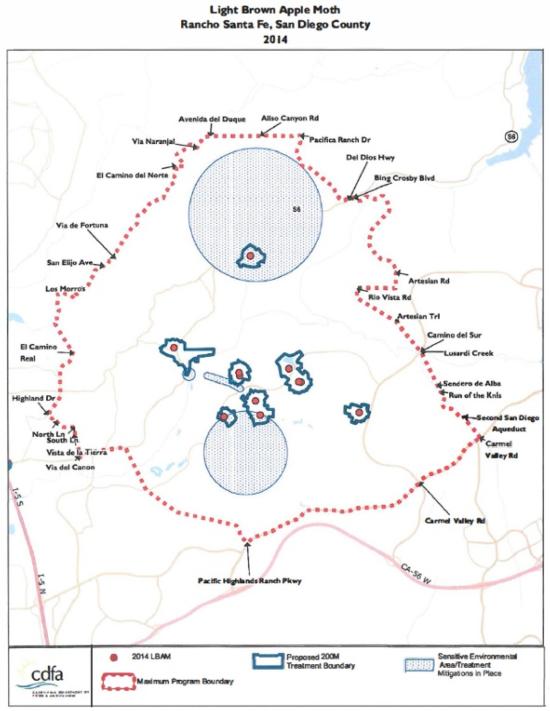Fall 2014: Light Brown Apple Moth Update
Regional Report for San Diego and Riverside Counties by James A. Bethke
The light brown apple moth (LBAM) needs no introduction because UC Cooperative Extension has been providing research and education about this pest since its introduction in California in 2007. In San Diego County, it has been detected a number of times over the last few years and most of the infestations have been eradicated. However, a lingering infestation occurs in the Oceanside area (fig. 1). In March 2014, 10 separate detections of the LBAM were observed in Rancho Santa Fe and, due to the level of detection, it is assumed that a breeding population exists in the area (fig. 2). This means that the infestation will need an eradication effort and special mitigation due to environmentally sensitive areas within the eradication zone.

The ornamental plant production industry has not been seriously impacted by the Oceanside infestation, but the new infestation in Rancho Santa Fe threatens numerous growers. San Diego growers have been prepped for the required regulatory actions by San Diego County Department of Agricultural Weights and Measures and by the California Department of Food and Agriculture, but it is now likely that the industry needs to get serious about their preparations. In the references below are links to the most pertinent information available. In short, all nurseries should begin to follow the best management practices against LBAM. All the required information specifically for San Diego County growers can be located at the San Diego County Department of Agriculture Weights and Measures’ web page.

Shipping requirements are different depending on whether the plant producer is located inside the state interior quarantine area (within 1.5 miles of a detection) or outside. If they are inside the state interior quarantine, growers are required to have inspections every 30 days and the grower must have a certificate of quarantine compliance (CQC), which needs to accompany any intrastate shipments. However, a federal shield can be used in lieu of a CQC. If the plant producer is located outside the state interior quarantine, a single inspection is required. A federal shield must accompany all interstate shipments. All growers must be trapping at a rate of one trap per five acres or at least one trap if less than five acres. There are other requirements for harvested commodities, so see the links on the County’s web page.
References
[CDFA] California Department of Food and Agriculture. Light brown apple moth (LBAM). http://www.cdfa.ca.gov/plant/lbam/index.html. (includes all relevant information, maps and nursery regulations.)
San Diego County Department of Agriculture Weights and Measures. Light brown apple moth quarantine. http://www.sandiegocounty.gov/awm/LBAM.html.
[CANGC] California Association of Nurseries and Garden Centers. 2009. Light brown apple moth (LBAM) Nursery Industry Best Management Practices. http://www.cdfa.ca.gov/plant/lbam/rpts/LBAM_BMP-Rev_3.pdf.
Tsjosvold, SA, Murray NB, Epstein M, Sage O, Gilligan T. Field Identification Guide for Light Brown Apple Moth in California Nurseries.
(Guide and training video are available under “Emerging Pests” at: http://www.ipm.ucdavis.edu/PMG/selectnewpest.floriculture.html.)
James A. Bethke
Farm Advisor, Nurseries and Floriculture
UC Cooperative Extension San Diego, North County Office
151 E. Carmel St., San Marcos, CA 92078
(760) 752-4715 phone; (760) 752-4725 fax
jabethke@ucdavis.edu
http://cesandiego.ucdavis.edu/












